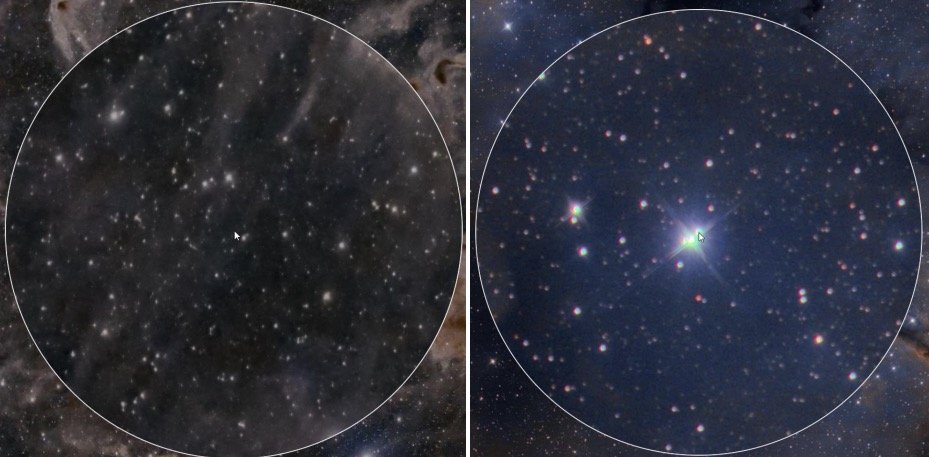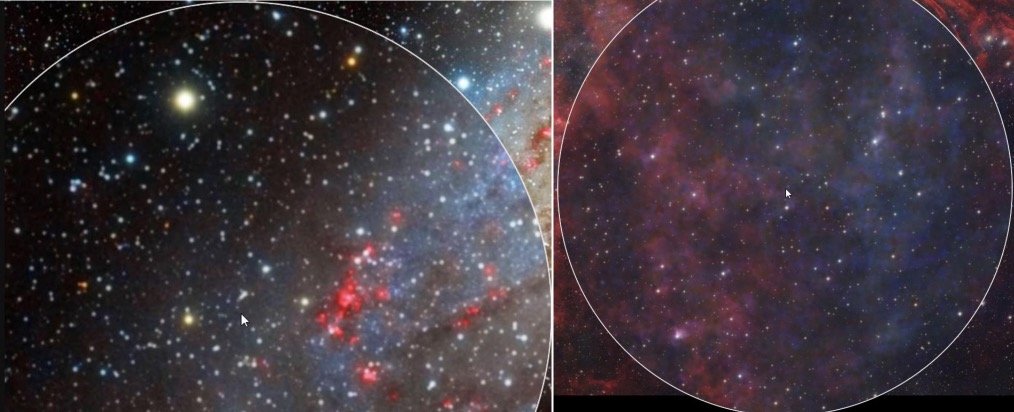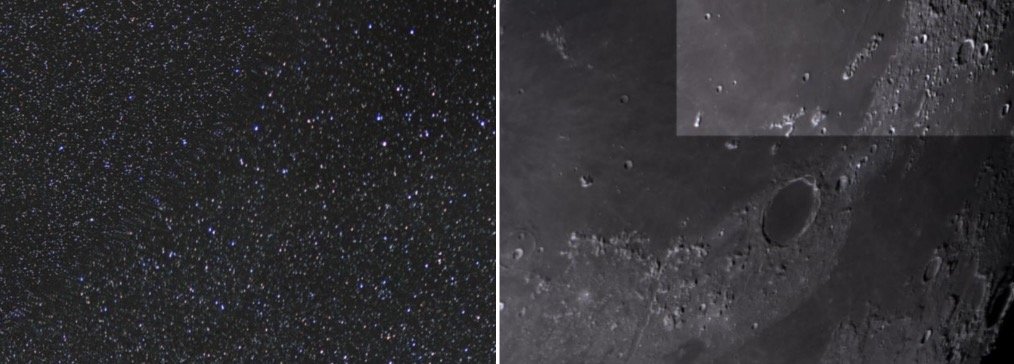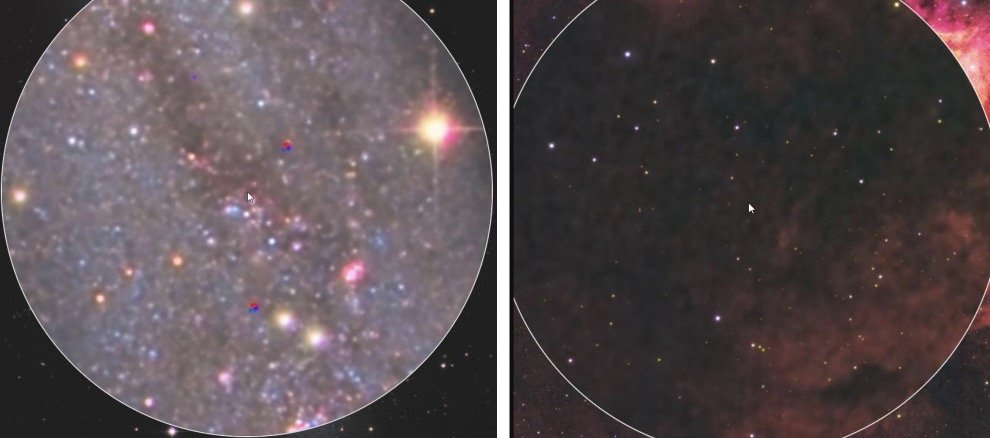
The Image of the Day
A compendium and manifesto.
⬇
The “AstroBin Image of the Day and Top Picks”, hereby abbreviated as IOTD/TP, is a long-running system to promote beautiful, interesting, peculiar, or otherwise amazing astrophotographs, with a focus on technical excellence.
Principles
The IOTD/TP is not a competition, despite the fact it might give this impression: there are no prizes and the goal is not to determine whether an image is better than another or an astrophotographer better than their peers.
Its goal is to promote the output of the amateur astrophotography community to a wider audience, thus increasing interest in this wonderful hobby.
Its secondary goal is to promote excellence: astrophotography is a highly technical hobby, with a steep and long learning curve, and everybody has room for improvement.
The IOTD/TP does not want to represent itself in a way that is discriminatory of astrophotographers or images, and is supposed to be agnostic of:
Subject category (deep-sky, solar system, terrestrial phenomena…)
Price of the equipment used
Location of the image acquisition
Method or process of the image acquisition
This means that images acquired with cheaper equipment are not categorized differently than images acquired with very expensive equipment. The same goes for images acquired under light-polluted city skies versus images acquired under pristine and dark skies. Additionally, the same applies to images acquired in one's backyard versus images acquired at a dedicated remote location.
Please note: images that are selected as IOTD/TP should, in principle, display excellence in some form (be it acquisition, processing, or another part of the process). Occasionally, there might be exceptions: it is sometimes possible to trade some technical excellence for some other qualities (such as originality, composition, special events or conditions). However, even in those cases, IOTD/TP images should have a high standard of technical quality.
Rules
As for all images published on AstroBin, you are only allowed to publish images for IOTD/TP consideration if you have personally worked on them (this means either acquisition, processing, or both). However, you may not download a ready-made space telescope or professionally observatory image, alter it marginally, and submit it to the IOTD/TP. Processing must have started from reasonably raw data.
Submitting an image that you already submitted in the past is forbidden. This applies also in the event in which you completely re-processed the image, or you added data to it. Only brand new data may be submitted again as a new image for IOTD/TP consideration. Crops, re-processed data, minor additions of data, and mosaic panels should be uploaded as image revisions. However:
If you added a significant amount of new data (or data with vastly better equipment), the image may be submitted anew. The meaning of the word “significant” will be left to the common sense of the photographer. We are only trying to prevent gaming the system by adding one minute of data. You know what we mean.
If you reprise a project after a year (due to an object reappearing when the season is right) it will be generally be allowed to repost to the IOTD/TP process under a much looser meaning of the words “significant amount of new data”. As above, common sense needs to be applied: just don't try and game the system.
Submitting an image multiple times as multiple members of a team is forbidden. If you're part of a team (e.g. you share equipment, a remote observatory, data…) and you process the same data individually, only one instance is allowed to be submitted to the IOTD/TP. The correct way to handle this situation is that one member of the team uploads the image to their gallery, and tags the other members as collaborators. Multiple takes on processing the data can be added as revisions. Another option would be to create an additional AstroBin account for the group. The following cases constitute exemptions to this rule:
Massive ad-hoc collaborations of people who are otherwise not connected as being part of a team and do share resources regularly.
Ad-hoc projects that reuse older data in order to achieve very long integration times or create very large mosaic, as long as the data does not come from people who regularly collaborate.
Failure to respect the rules above may incur in the removal of an image from the IOTD/TP selection process, in the stripping of its awards, or, in case of recidivism, a temporary or permanent ban in participating the IOTD/TP. AstroBin reserves the right to freely interpret the rules above where there is room for interpretations. AstroBin reserves the right to change the rules above in the future. Should that happen, you will be automatically prompted to accept them on AstroBin.
Changelog
2024-03-04: instead of referring to the Hubble Space Telescope, the rules now mention “space telescopes” in a more generic way. As this is a minor change and pretty common sense, no explicit agreement is required by the users.
2023-11-26: added section about exemptions to rule 3. As this change looses the rules rather than restrict them, no explicit agreement is required by the users.
2023-11-14: added note about reprising a project after a year. As this change looses the rules rather than restrict them, no explicit agreement is required by the users.
2023-11-09: first publication of formalized IOTD/TP rules. For all intents and purposes, no rule change applied, except that now they are written down.
Process
The IOTD/TP works like a funnel and is comprised of 3 teams. Images progress over 3 stages, and the first 2 stages are presented with anonymized images in order to minimize the risk of unconscious biases.
The Staff appointment process
Anybody who wants to take part of the process can apply by filling this online form. Once a year, the list of applicants is reviewed and the staff is replenished with viable candidates.
Stage 1: Submitters
There are approximately 60 members of the IOTD/TP staff with the role of Submitter. Every time an image is made public on AstroBin, it is sent to a random sample of 50% of the Submitters.
Each Submitter goes through their daily queue to inspect the new images, and they may decide to promote some of them to the next stage.
An image will sit in a Submitter's queue for up to 48 hours. If an image is not viewed by at least 80% of the designated Submitters, it is automatically resubmitted and assigned to the other 50% of Submitters.
If an image is independently promoted by 3 distinct Submitters, it advances to the next stage of the process. Unless it later gains a better status, it will be awarded the Top Pick Nomination bronze badge once it has run its course through the process entirely.
However, if an image is dismissed by 5 distinct Submitters, it is instantly removed from everybody's queues at all levels. If this happens after 3 promotions are reached, tho, the image will not lose its Top Pick Nomination status.
The Submitters are constrained by the following rules:
They cannot promote their own images or images they collaborated to.
They cannot promote more than 6 images in a period of time that goes from midnight UTC to the next midnight UTC.
Stage 2: Reviewers
There are approximately 20 members of the IOTD/TP staff with the role of Reviewer. Every time an image is promoted by 3 Submitters or more, it is sent to a random sample of 50% of the Reviewers.
Each Reviewer goes through their daily queue to inspect the new images, and they may decide to promote some of them to the next stage.
An image will sit in a Reviewer's queue for up to 120 hours (5 days) since the last promotion by a Submitter.
If an image is independently promoted by 3 distinct Reviewers, it advances to the next stage of the process. Unless it later gains a better status, it will be awarded the Top Pick silver badge once it has run its course through the process entirely. Top Picks are shared on Facebook and Instagram as “stories”.
However, if an image is dismissed by 5 distinct Submitters or Reviewers, it is instantly removed from everybody's queues at all levels. If this happens after 3 promotions are reached, tho, the image will not lose its Top Pick status.
The Reviewers are constrained by the following rules:
They cannot promote their own images or images they collaborated to.
They cannot promote more than 4 images in a period of time that goes from midnight UTC to the next midnight UTC.
If a Reviewer acts as a Submitter too, they cannot promote an image if they have previously promoted it as a Submitter. Covering multiple roles is not the norm but it could happen if there's a shortage of volunteers for one role.
Stage 3: Judges
There are 8 members of the IOTD/TP staff with the role of Judge. Every time an image is promoted by 3 Reviewers or more, it is sent to every Judge.
Each Judge goes through their daily queue to inspect the new images, and they may unilaterally and independently decide to make one of those images IOTD. There is no consensus or casting of votes at this stage. However, Judges may comment and discuss each other’s choices.
An image will sit in a Judge's queue for up to 168 hours (7 days) since the last promotion by a Reviewer.
When a Judge makes an image an IOTD, it is assigned the first available future day without an IOTD. IOTDs are awarded the IOTD golden badge and are shared on Facebook, Instagram, and Twitter as posts.
The Judges are constrained by the following rules:
They cannot elect their own images or images they collaborated to.
They cannot elect more than 1 image in a period of time that goes from midnight UTC to the next midnight UTC.
They cannot hold more than 2 future IOTDs.
Once 7 future IOTDs are determined, a new election is not possible for that day.
If a Judge acts as a Submitter and/or a Reviewer too, they cannot promote an image if they have previously promoted it as a Submitter or a Reviewer. Covering roles is not the norm but it could happen if there's a shortage of volunteers for one role.
Staff guidelines
While a large IOTD/TP team ensures diversity and variety, and the redundancy built into the system ensures that images don't go unnoticed, it is important, as a team, to be on the same page and work towards the same goal (denoted above).
This section clarifies some generic guidelines, or rules of thumb, for image selection.
Please remember: these are rules of thumb, and they can be broken.
The IOTD/TP staff operates under the guidelines below.
Technical requirements
In general, an image should not present the following technical shortcomings, in order to be considered for IOTD/TP:
Poor stars: streaks, ovals, out of focus, dark ringing, bloating, misregistration.
Over-sharpening: white fringe at the edge of planets, or deep-sky features appearing embossed.
Registration artifacts: e.g. at the edges of the image and in the corners.
Insufficient integration time: i.e. the image appears grainy.
Excessive noise reduction: i.e. delicate details appear over-smoothed.
Topaz NR Overdone: i.e. over-sharpened structures and creation of nonexisting ‘Hubble like’ details.
Overly saturated colors or banding.
Inadequate background correction: gradients, light pollution, or vignetting.
Clipped highlights or blacks: space generally isn’t rendered pure black.
Other: improperly adjusted panels within a mosaic, misalignment, poor stitches.
Visual impact considerations
Originality: have I seen that object before? If so, have I seen it treated/processed like this before?
Does it tell or illustrate a story or a unique scientific event?
Is it well composed (perhaps considering the Rule of Thirds), or has the photographer merely placed the object in the middle of the frame with no consideration for its context or surroundings in space?
Is it well framed, or has the object been cut off (and have secondary objects also been cut off randomly at the edges of the frame)?
If a narrowband image, is the color palette harmonious and pleasing, or if LRGB, is the color accurate?
Special considerations for Judges
The same object should not be selected within a few days.
The same data with just different processing (e.g. in the case of imaging teams) should not be selected again.
A specific imaging technique, equipment set, or location should not be favored over another.
There should be no discrimination or personal bias, while of course there is room for personal preferences.
Photographer guidelines
If you want to submit your images for IOTD/TP consideration, please do read the technical requirements explained in the staff guidelines above. Knowledge of what constitutes a reason to dismiss an image can help you improve your chances to see your image recognized.
The images below provide examples of things to avoid.
Upload images that look good when viewed at full size. Too small or too large images might make it difficult for a staff member to correctly evaluate them.
Star shape is a telling sign of the overall quality of your optical train and your processing skill. Avoid the following mistakes in stars: streaks, ovals, out of focus, dark ringing, bloating, misregistration.
Avoid “panda eye” stars, often a symptom of excessive deconvolution.
Avoid over-sharpening your images. This is often evident in the form or white fringe at the edge of planets, or deep-sky features appearing embossed.
Avoid registration artifacts at the edge of your image. If you dithered, remember to crop your image so that those defects are discarded.
Images that are very noisy or grainy due to light-pollution or insufficient integration times are not a good fit for the IOTD/TP.
Avoid excessive noise reduction, which causes images to appear artificially smooth.
Avoid excessive use of AI based noise reduction algorithms (e.g. Topaz AI or BlurXTerminator). If abused, they introduce artifacts in the way some areas are too sharp and present made-up details.
Avoid excessive saturation or color banding artifacts.
Avoid incorrect color balances in the background, gradients, and vignetting.
Avoid clipping the blacks or the highlights. Generally speaking, the sky background shouldn't be pure black.
Avoid improperly adjusted panels within a mosaic, misalignment, or inadequate stitching.
Avoid hot/cold pixels, color fringes around stars, and spotty backgounds.
Team
Judges
https://www.astrobin.com/users/Andys_Astropix/
https://www.astrobin.com/users/Barry-Wilson/
https://www.astrobin.com/users/Christophorus/
https://www.astrobin.com/users/dmkusz/
https://www.astrobin.com/users/_Frank_/
https://www.astrobin.com/users/astrojoe/
Reviewers
https://www.astrobin.com/users/AccidentalAstronomers/
https://www.astrobin.com/users/Adry/
https://www.astrobin.com/users/AliAlhawas/
https://www.astrobin.com/users/astrofalls/
https://www.astrobin.com/users/bilgebay/
https://www.astrobin.com/users/bsteeve/
https://www.astrobin.com/users/gorann/
https://www.astrobin.com/users/gorante/
https://www.astrobin.com/users/Hartmuth_Kintzel/
https://www.astrobin.com/users/jeff2011/
https://www.astrobin.com/users/kevinldixon/
https://www.astrobin.com/users/m_abdulkareem/
https://www.astrobin.com/users/Morrisayoder/
https://www.astrobin.com/users/Robert_Schumann/
https://www.astrobin.com/users/shirejedi/
https://www.astrobin.com/users/silkpericles/
https://www.astrobin.com/users/Wanda.Conde/
Submitters
https://www.astrobin.com/users/1loosetooth/
https://www.astrobin.com/users/abusrodas@gmail.com/
https://www.astrobin.com/users/AdrienK/
https://www.astrobin.com/users/a.erkaslan/
https://www.astrobin.com/users/alexbb/
https://www.astrobin.com/users/-Amenophis-/
https://www.astrobin.com/users/ams.astrophotography/
https://www.astrobin.com/users/AstroCHL2JPN/
https://www.astrobin.com/users/astroyyc/
https://www.astrobin.com/users/balasia/
https://www.astrobin.com/users/Benjaminlaw/
https://www.astrobin.com/users/bmantooth/
https://www.astrobin.com/users/canopo100/
https://www.astrobin.com/users/Carballada/
https://www.astrobin.com/users/carted2/
https://www.astrobin.com/users/cashew/
https://www.astrobin.com/users/deckardbr/
https://www.astrobin.com/users/DiscoDuck/
https://www.astrobin.com/users/dstern/
https://www.astrobin.com/users/equinoxx/
https://www.astrobin.com/users/framoro/
https://www.astrobin.com/users/Geoff/
https://www.astrobin.com/users/Gmadkat/
https://www.astrobin.com/users/grsotnas/
https://www.astrobin.com/users/GuillaumeGz/
https://www.astrobin.com/users/Hartmuth_Kintzel/
https://www.astrobin.com/users/HR_Maurer/
https://www.astrobin.com/users/Jakub_Szyma/
https://www.astrobin.com/users/Jedi2014/
https://www.astrobin.com/users/John.Dziuba/
https://www.astrobin.com/users/JohnHen/
https://www.astrobin.com/users/K.Bahr/
https://www.astrobin.com/users/kevinldixon/
https://www.astrobin.com/users/Lancelot365/
https://www.astrobin.com/users/Lorenzo_Premoli/
https://www.astrobin.com/users/Lowind/
https://www.astrobin.com/users/Markus_Blauensteiner/
https://www.astrobin.com/users/martindufour/
https://www.astrobin.com/users/mesh83/
https://www.astrobin.com/users/morefield/
https://www.astrobin.com/users/nodustab/
https://www.astrobin.com/users/orion13/
https://www.astrobin.com/users/Papangue/
https://www.astrobin.com/users/pete_xl/
https://www.astrobin.com/users/PhotonPharmer1/
https://www.astrobin.com/users/plane/
https://www.astrobin.com/users/Rafal_Szwejkowski/
https://www.astrobin.com/users/rallyho/
https://www.astrobin.com/users/renan/
https://www.astrobin.com/users/RonaldNC/
https://www.astrobin.com/users/Rudi_VanMinnebruggen/
https://www.astrobin.com/users/sasho_mk/
https://www.astrobin.com/users/SemiPro/
https://www.astrobin.com/users/sunlover/
https://www.astrobin.com/users/Tackettbr/
https://www.astrobin.com/users/TheFinePrint/
FAQ
“An image selected as Top Pick or IOTD is not very good. Why?”
The IOTD/TP process is performed by humans, volunteers with limited time. For the most part, these volunteers are amateur astronomers, not professionals. It’s very likely that, occasionally, an image will be awarded but some people will think it didn’t deserve it: astrophotography is not an exact science and there is a strong "personal preference” factor.
Additionally, since there are no objective, unarguable measures of an image worthiness to IOTD/TP status (besides the guidelines above), images awarded with an IOTD/TP award tend to be those that follow a style that is currently trending. They tend to be catchy images with something “special” about them.
Finally, the IOTD/TP awards are not only about how good an image is. Please read the first paragraph on this page again.
“My image is better than the recent IOTD/TP images, yet it wasn’t awarded. Why?”
Assuming that you did submit your image for IOTD/TP consideration using the Actions menu, or that you have auto-submission enabled in your preferences, you have to consider a few things:
The IOTD/TP is not a deterministic system, due to the fact that humans are involved. People might overlook an image, or simply not like it as much as you did. Or they might miss a factor that makes it theoretically IOTD/TP worthy due to lack of time.
There can be only one IOTD per day, by definition, and Top Picks are also limited by the fact that voters have a limited number of votes available each day. The IOTD process can take up to 4 weeks (from publication to selection) so the fact that recent IOTD/TP images are not as good as your image, in your opinion, is no matter, because it doesn’t mean that those were the images “competing” for votes with your image at the same time.
The IOTD/TP process is a complex one with many variables involved, and the number of great images on AstroBin surpasses the output of the process. However, lowering the bar in order to let more images win an award will also carry the risk of letting some sub-par images thru the cracks, which will undermine the credibility and prestige of the IOTD/TP system.
“I feel that images acquired with expensive equipment / from pristine skies / from remote hosting facilities get awarded too often. Why isn't the IOTD/TP process split in categories?”
The IOTD/TP is not a competition for the best image, but a system to promote beautiful, interesting, peculiar, or otherwise amazing astrophotographs, with a focus on technical excellence. Large telescopes at pristine remote locations have a tendency to yield better images, to nobody's surprise. The goal is to promote astrophotography, awe people, and reach a wider community (IOTDs are often somewhat viral on social media): for this reason, there are no weight classes.
Moreover, drawing the lines to come up with categories would be very difficult indeed, and it would be a slippery slope leading to even more categories. For instance, what constitutes a “remotely acquired image” as opposed to a “backyard image”? Do we draw the line at "downloaded data"? Or at "remotely acquired with rented time"? What about "remotely acquired with own equipment"? What about "remotely acquired but from the shed on my property 100 yards from the house"? What about "backyard but I live in the desert at 2000 meters of elevation and my equipment is worth $500,000"?
Do we require a different category for people who travel 1 hour to a remote location? What if they drive 5 hours?
Do we require a different category for people who do manual guiding? What about film cameras?
Do we require different categories according to how expensive your equipment is?
Do we require different categories for deep-sky vs solar system objects? What about compositions? What about northern lights?
As you surely understand by now, this is quite complicated, and so far AstroBin has preferred to keep things simple.
“Okay fine, but what about purchased/download data? Surely that needs to be categorized differently!”
The AstroBin IOTD/TP is inclusive. Post-processing images is a very important aspect in the production of a finished astrophotograph, and dismissing or diminishing someone's effort because they were “merely” post-processing is gatekeeping, and it doesn't sit well with AstroBin's principles.
There might be several reasons why somebody chooses to purchase ready-made raw data instead of acquiring their own. For instance, they might not be able to afford a complete astrophotography setup, they might be dipping their toes in the water, they might live in a Bortle 9 area and not have time to travel due to work or family, they might have disabilities that prevent them from handling equipment.
AstroBin does not pretend to judge whether or not your astrophotography is “the real” astrophotography, and there are plenty of things to learn and mistakes to make, when it comes to post-processing data.
Furthermore, at the time of writing only 4% of IOTDs are categorized as having a “remote hosting facility” as data source. Some of the images in that 4% will be from people who have rented time and scheduled their observation, and some will be from people who have downloaded readily available data.
“Are image revisions considered in the IOTD/TP process?”
During the time an image is in the IOTD/TP process, the members of the jury will always see the final revision (may it be the original upload or a later revision that has been marked as final).
Adding a final revision to an image does not make it enter the IOTD/TP process again, or start it from the beginning, but it simply replaces what the members of the jury see when they log in to vote.
“My image has been X days in the IOTD/TP process, and received Y votes by Submitters/Reviewers. Why doesn't it show an award badge?”
AstroBin only assigns badges to images once they're final. For instance, your image might be out of the Submitters queues and have received enough votes for a Top Pick Nomination, but if it's still in the Reviewers queues then it still has a chance to make it to Top Pick or IOTD.
How long an image will remain in the IOTD/TP queues depends on how much it advances. These are some typical scenarios:
Early exit
If an image receives 5 Dismissals by Submitters, it could exit the process as quickly as 30 minutes after submission by the photographer, or up to 48 hours after submission.Top Pick Nomination exit
If an image receives 3+ Promotions by Submitters and reaches the Reviewers’ queues, but then it reaches a total number of Dismissals of 5, it could exit the queue with a Top Pick Nomination award. This could take between 2 and 9 days.Top Pick exit
If an image receives 3+ Promotions by Submitters and 3+ Promotions by Reviewer (and fewer than 5 Dismissals) it will go on to enter the final queue: the Judges, and sit there for up to 7 days. If the image is not made IOTD by a Judge, it will exit the process with a Top Pick award between 7 and 14 days after submission.IOTD exit
When an image reaches the Judges’ queues, it could become IOTD for the very next day (very unluckily as the IOTD schedule is usually filled up for 4-5 days in advance) or sit in the queue for 7 days, and on the last day be made IOTD for 7 days in the future. This means that there could be between 2 and 14 days from the time an image has received 3 Reviewer Promotions to the time it becomes IOTD.Fast track
Theoretically, an image could move very quickly thru the process: receive 3+ Submitters votes immediately, receive 3+ Reviewer votes immediately, be made IOTD immediately. This could cause an image to become IOTD the very next day, although it's extremely unlikely.
Considering all the steps above, an image could be in the IOTD/TP process up to:
4 days in case of no award (normally 2 days, but sometimes two more in case not enough Submitters viewed a certain image)
9 days in case of Top Pick Nomination award
16 days in case of Top Pick award
30 days in case of IOTD














